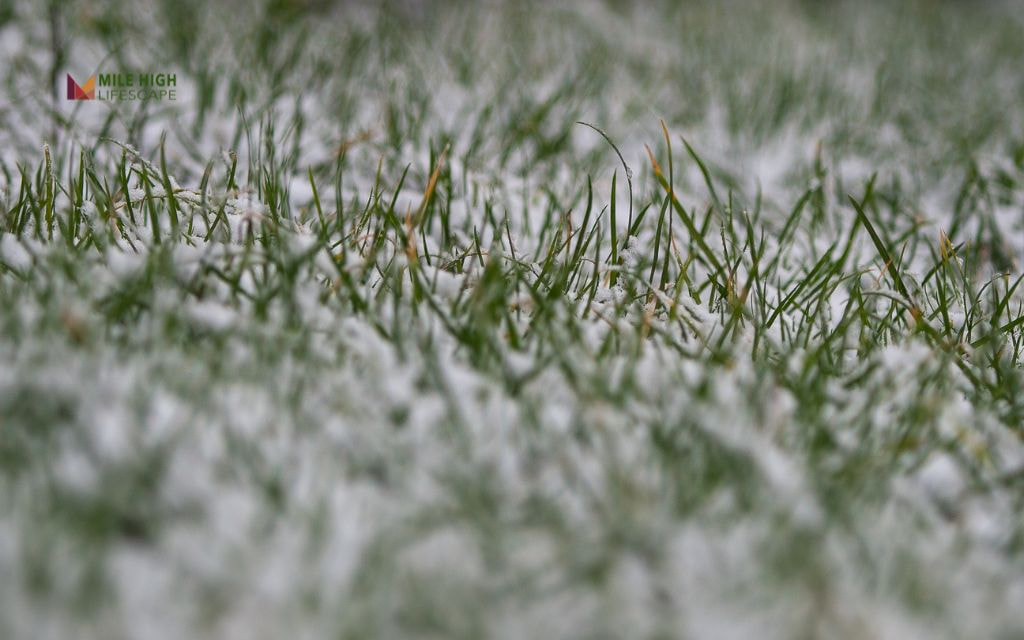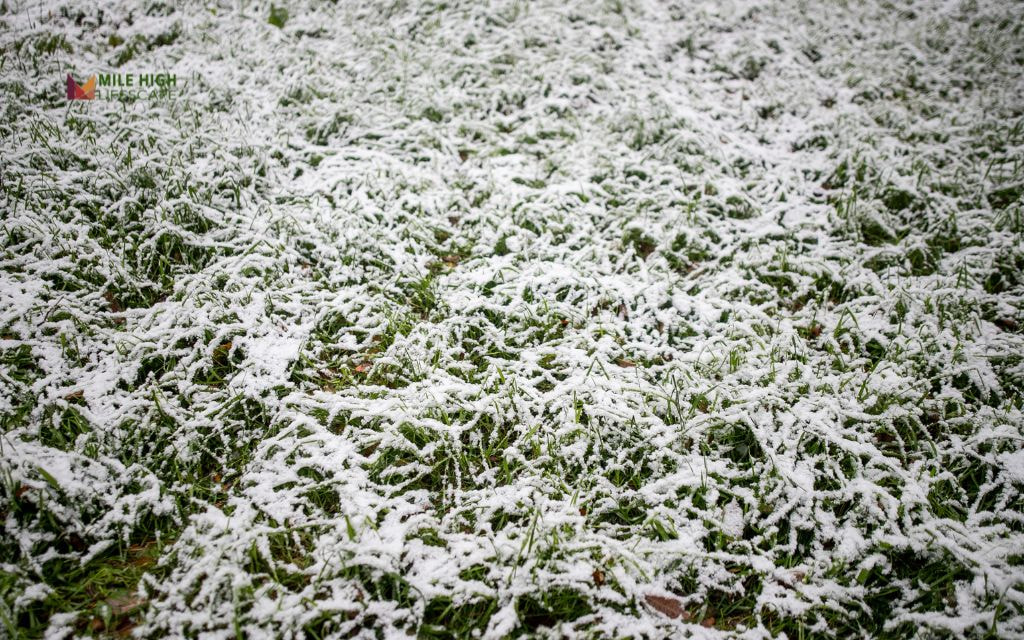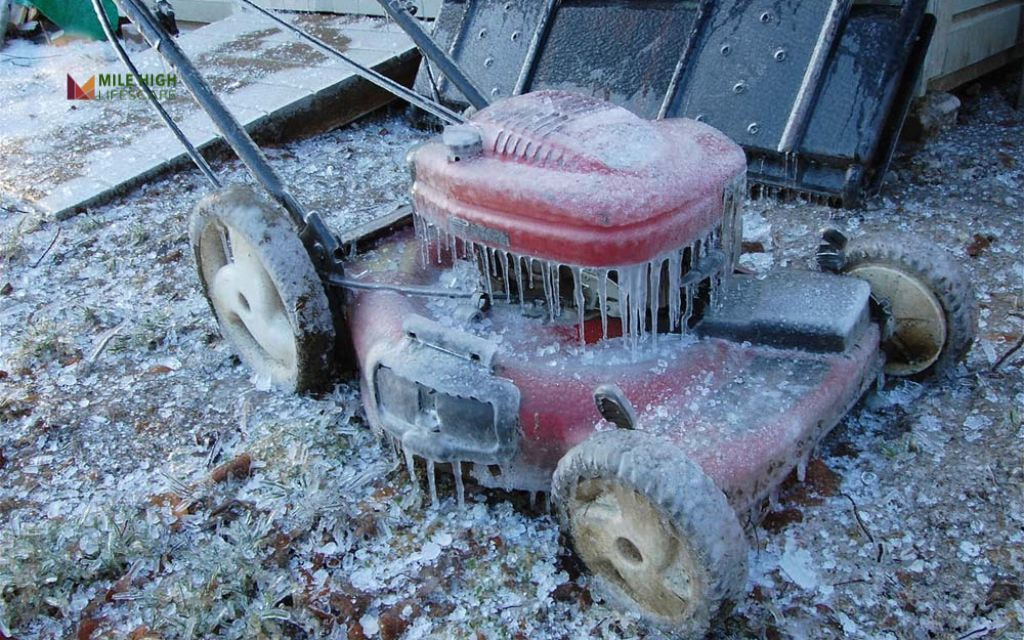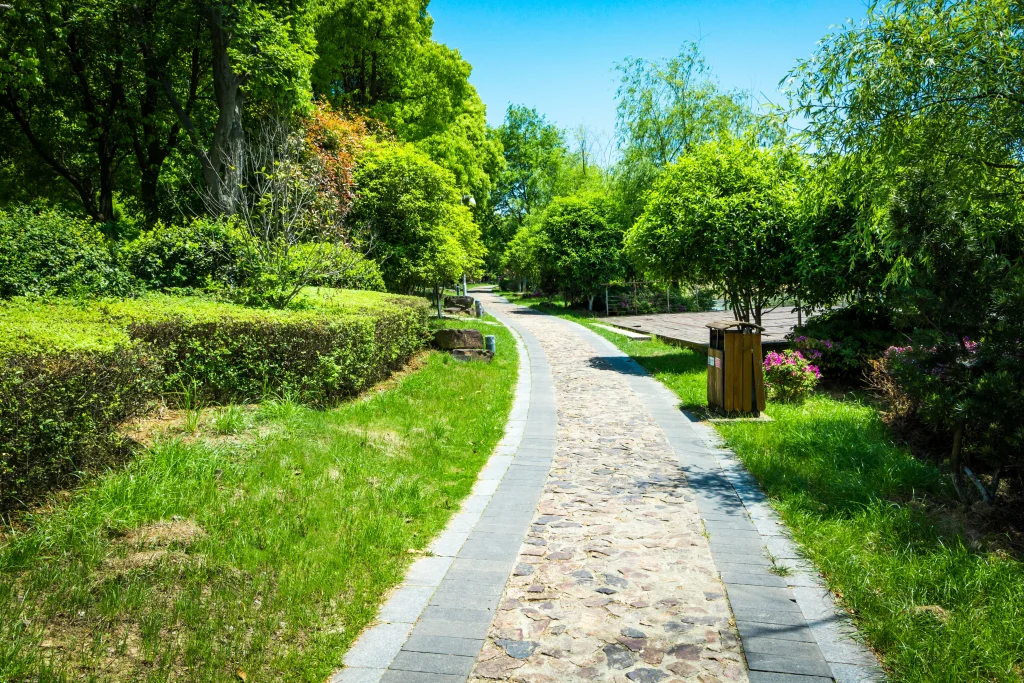How to winterize a lawn? To prepare your lawn for winter, focus on reducing stress and promoting healthy growth during the colder months. Important steps include mowing, raking, aerating, fertilizing, and overseeding.
Denver’s unpredictable winter conditions present unique challenges for lawn care. The Mile High City experiences dramatic temperature swings, from mild autumn days to sudden snowstorms that can dump several inches overnight.
These freeze-thaw cycles create stress on grass that requires specific preparation strategies.
This comprehensive guide will teach you how to winterize lawn with 7 simple steps. You’ll also learn the timing for each task, methods that work, and common mistakes that cost you hundreds in spring repairs.
7-step guide: How to winterize lawn in Denver
Step 1: Raking and removing debris
Leaves and debris create barriers that prevent sunlight from reaching grass blades. In Denver’s dry climate, these organic materials also trap moisture against the soil surface, creating perfect conditions for fungal diseases like snow mold.
Remove all leaves, sticks, and organic debris using a leaf rake or backpack blower. Pay special attention to areas under trees and along fence lines where debris accumulates.
For large properties, consider mulching light leaf cover directly into the lawn using a mulching mower, but only if the layer is thin enough that grass remains visible underneath.
Complete debris removal before Denver’s first significant snowfall, typically occurring between late October and mid-November.
Step 2: Mowing the lawn
Proper mowing height prevents snow mold formation while protecting grass crowns from extreme temperature fluctuations. Grass that’s too long creates matted conditions under snow, encouraging fungal growth.
Conversely, grass cut too short exposes root systems to Denver’s harsh winter winds and freeze-thaw cycles.
Set your mower deck to maintain grass height between 2 and 3 inches for cool-season grasses common in Denver, including Kentucky bluegrass and tall fescue.
Perform your final mowing when daytime temperatures consistently remain below 50°F, typically in mid to late October. This timing allows grass to enter dormancy naturally while maintaining protective height through winter months.
Step 3: Aerating your lawn
Aeration creates channels that allow winter precipitation to reach root zones and prevents water from pooling on the surface where it can freeze and damage grass crowns.
Use a core aerator to remove soil plugs approximately 3 inches deep and spaced 4 inches apart. Focus on high-traffic areas, slopes, and locations where water typically pools after storms.
Leave soil cores on the lawn surface where they will break down naturally, adding organic matter to improve soil structure.
Complete aeration between late September and mid-October when soil contains adequate moisture but before ground temperatures drop below 45°F.
Avoid aerating during drought conditions when soil becomes too hard, or after heavy rains when clay soil becomes sticky and compacted.

Step 4: Fertilizing for winter hardiness
Apply a winterizer fertilizer with a 3-1-2 or 4-1-2 NPK ratio, emphasizing potassium content. Use slow-release formulations that provide nutrients gradually rather than quick-release fertilizers that can burn grass or promote late-season growth vulnerable to frost damage.
Apply according to manufacturer rates, typically 1 to 1.5 pounds of nitrogen per 1,000 square feet.
Apply winterizer fertilizer in early November, 6 to 8 weeks before the ground freezes solid. This timing allows nutrients to move into root zones before winter dormancy begins while avoiding late growth that frost can damage.
Step 5: Watering your lawn before winter
Hydrated grass cells resist freeze damage better than dehydrated ones. Adequate soil moisture also prevents desiccation damage that appears as brown, dead grass in spring.
Provide deep, infrequent watering sessions that penetrate 6 to 8 inches into the soil. Apply approximately 1 inch of water weekly if natural precipitation is insufficient.
Water early in the day to allow grass blades to dry before evening temperatures drop, reducing disease risk. Continue watering until soil temperatures consistently remain below 40°F, typically in mid to late November.
Step 6: Mulching your lawn
Organic mulch provides insulation that moderates soil temperature fluctuations, protecting grass roots from Denver’s extreme freeze-thaw cycles.
Mulch also retains soil moisture during dry winter periods and suppresses winter weeds that can compete with grass in spring.
Apply a thin layer of organic mulch, such as finely shredded leaves or compost, no more than ¼ inch thick. Avoid thick applications that can smother grass or create anaerobic conditions. Focus mulch application on exposed areas, slopes, and locations where wind exposure is greatest.
Apply mulch in late October or early November before the first hard freeze but after completing all other winterization tasks.
Step 7: Inspecting irrigation system
Frozen water in irrigation lines can cause thousands of dollars in damage when pipes burst.
Shut off water supply to irrigation systems at the main valve. Drain all water from pipes, sprinkler heads, and backflow preventers. Use compressed air to blow remaining water from lines, starting from the highest elevation and working toward drainage points. Insulate above-ground components and backflow preventers with foam covers.
Complete irrigation system winterization before temperatures drop below 32°F for more than 4 consecutive hours. In Denver, this typically occurs in late October or early November, but monitor weather forecasts for unexpected early freezes.
Benefits of winterizing your lawn
Prevents freeze damage
Proper winterization strengthens grass cells to withstand Denver’s harsh freeze-thaw cycles. Protected root systems resist ice formation and temperature fluctuations that destroy unprepared lawns. This preparation prevents costly dead spots that require spring overseeding and repair.
Improves lawn health
Winterized lawns store essential nutrients and moisture more efficiently during dormancy. Deep root development encouraged by late-season care creates stronger turf that emerges vibrant in spring. Well-prepared grass naturally resists disease and pest pressure throughout the growing season.
Increases curb appeal
Healthy spring lawns begin with proper winter preparation. Winterized grass emerges earlier with better color and density, creating attractive landscapes that enhance property value.
Consistent care maintains the lush appearance that defines well-maintained Denver neighborhoods.
Reduces future lawn care costs
Preventive winterization eliminates expensive spring repairs and restoration projects. Protected lawns require fewer fertilizer applications, less overseeding, and reduced pest control treatments. The modest investment in winter preparation saves hundreds of dollars in subsequent maintenance costs.

What month should I winterize my lawn?
Begin the process in mid-September with aeration and early tasks, then complete all activities by mid-November before harsh winter conditions arrive.
October represents the optimal month for most winterization activities. Grass remains active enough to benefit from fertilization and watering, while soil temperatures support root development.
November should focus on final preparations like mulching and irrigation system protection.
Should I winterize my lawn mower?
Mower maintenance protects expensive equipment while ensuring reliable spring startup. Stale fuel damages carburetor components, while corrosion from moisture can destroy engine parts. Denver’s dry air and temperature fluctuations accelerate these problems.
- Clean grass clippings and debris from the mower deck, engine cooling fins, and air filter housing.
- Change engine oil and replace spark plugs if needed.
- Either run the engine until fuel is completely consumed or add fuel stabilizer to prevent gum formation in carburetor components.
- Store mowers in dry locations protected from temperature extremes.
- Cover equipment with breathable materials that prevent moisture accumulation while allowing air circulation.
- Check tire pressure and lubricate moving parts according to manufacturer recommendations.

Common mistakes to avoid when winterizing your lawn
- Waiting too long to start winterization: Delaying tasks until after the first snow prevents essential preparation like aeration and fertilization. Denver’s unpredictable weather can bring sudden storms that end your preparation window abruptly.
- Using wrong fertilizer type or timing: Applying high-nitrogen fertilizers late in the season promotes tender growth that freeze damage destroys. Conversely, skipping fertilization entirely leaves grass weakened and slow to recover in spring.
- Skipping lawn aeration: Ignoring soil compaction prevents water and air movement essential for winter survival. Denver’s clay soil requires annual aeration to maintain proper drainage and prevent winter kill in compacted areas.
- Cutting grass too short or too long: Mowing below 2 inches exposes roots to freeze damage, while grass over 3 inches creates matting under snow. Both extremes lead to spring damage and poor recovery.
- Forgetting irrigation system winterization: Failing to properly drain and protect sprinkler systems can cause thousands of dollars in damage when pipes freeze and burst during Denver’s temperature swings.
- Over-watering before winter: Excessive late-season watering creates soggy conditions that promote disease and ice formation around grass roots. Stop watering when soil temperatures consistently drop below 40°F.
Conclusion
Denver’s unique climate demands specific winterization strategies that address high-altitude conditions, clay soil challenges, and unpredictable weather patterns. Success requires understanding local timing, using appropriate techniques, and avoiding common mistakes that lead to expensive spring repairs.
The investment in proper winterization pays substantial dividends through improved spring emergence, reduced maintenance costs, and enhanced property value.
Following these 7-step guidelines on how to winterize your lawn to ensure vibrant grass growth when warmer weather returns.
Frequently asked questions (FAQs)
What to use to winterize a lawn?
Use slow-release fertilizer with high potassium content, organic mulch for insulation, and proper tools for aeration and debris removal. Denver lawns benefit most from winterizer fertilizers specifically formulated for cold climates and clay soil conditions.
Is it better to leave your lawn long or short for winter?
Maintain grass height between 2 and 3 inches for winter in Denver. This length provides adequate insulation for roots while preventing snow mold formation. Avoid cutting too short, which exposes roots to freeze damage, or leaving too long, which creates matting under snow.
How often should I water my lawn before winter?
Water deeply once weekly until soil temperatures drop below 40°F, typically in mid-November. Provide approximately 1 inch of water including natural precipitation. Monitor soil moisture levels and adjust frequency based on Denver’s dry autumn conditions.
What’s the difference between aerating and dethatching my lawn?
Aeration removes small soil cores to improve water and air penetration, while dethatching removes organic buildup between grass and soil. Denver’s soil typically requires aeration for compaction relief, while thatch problems are less common in our dry climate.
Can I winterize my lawn myself or should I hire a professional?
You can handle basic winterization tasks like raking and mowing, but aeration and irrigation system winterization require specialized equipment and expertise. Professional services ensure proper timing, technique, and protection against Denver’s challenging winter conditions.
